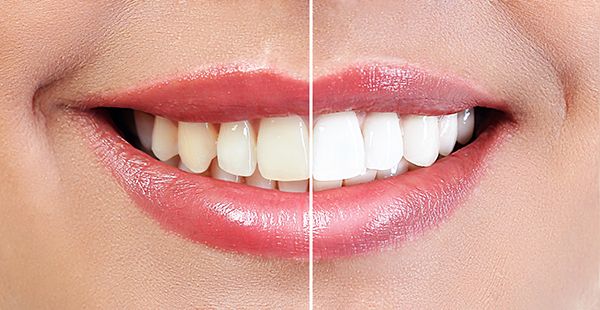HEALTHY TEETH WHITENING ALTERNATIVES

After years of coffee and tea drinking, maybe smoking cigarettes, cigars and chewing tobacco or even taking antibiotics, your once nice white teeth are starting to look a bit discolored…No matter how old a person is, perfect pearly white teeth are a must in the age of social media and selfies, but what is the “real cost” of these teeth whitening treatments? This is a very important question to ask…
Like many common dental procedures and materials that are available, most consumers are not thinking about the toxicity of the treatment, the damage that is done to the teeth, or even the dangers of the materials being used. Especially since you may use the same product for a long period of time. You simply go to the store and look for the tooth treatment that boldly claims if you use this product you will have a “whiter-brighter” smile!
Even though tooth enamel is the hardest substance in the body, it is also porous, which means it can be affected by what we eat and drink, especially eating acidic foods and drinking carbonated beverages and fruit juices. Unfortunately, our enamel cannot regenerate itself.
This is why in theory, teeth whiteners may sound great, but in reality, these products can actually be toxic because they can infiltrate the enamel. Other problems that can occur from teeth whiteners are tooth sensitivity, toxicity to cells (cytotoxicity), and gum (gingival) irritation.
A recent study looked at the biocompatibility and abrasiveness of various whitening and conventional toothpastes. The ingredients included:
- Carbamide peroxide – can cause stomach upset, an episode of vomiting or throat irritation if swallowed.
- Hydrogen peroxide – can damage enamel if used in high concentrations for long periods of time – can burn gums, tongue, and roof of the mouth.
- Sodium lauryl sulfate (the most toxic agent used as a detergent)- significant toxic effects in vitro.
Hydrated silica – may be toxic to the liver. - Aluminum oxide – may cause oxidative stress and cell death in liver and kidney tissues.
- Sodium monofluorophosphate – can be cytotoxic – can cause enamel defects.
- Sodium benzoate- a chemical preservative may cause kidney and liver injury.
- Assorted preservatives, colors, flavors, essences, and buffering agents were found.
In this study, they used human gingival fibroblasts with assorted dilutions that were exposed to various toothpaste to determine cytotoxicity and genotoxicity. They found some of the whitening toothpaste was significantly cytotoxic, while some of the conventional toothpaste caused significant enamel changes. What can also become a problem with these ingredients is that they can become more toxic when combined with each other.
Thankfully there are other options such as using natural teeth whitening alternatives which should lighten the natural color of teeth without eroding the dental surfaces. Some safer – milder natural teeth-whiteners that also contain organic acids include:
- Lemons
- Limes
- Apples
- Grapes
- Cherries
- Strawberries
- Oranges
- Papaya
- Pineapple
- Banana peel
These various natural components/compounds have been found to whiten teeth naturally:
- Limonene found in citrus fruit peel essential oil
- L-ascorbic acid (vitamin C).
- Citric acid
- Malic acid
- Phthalimido peroxy caproic acid found in Vanilla Fruits
- Bromelain and Papain – found in papaya and pineapple
- Aloe Vera juice
- Sodium bicarbonate
The takeaway is that while there are many over-the-counter products that exist to whiten teeth, they may wind up doing more harm than good over time. Using natural remedies is always going to be a better choice, especially when it comes to your oral health!
***
This article comes courtesy of our sister company, The Huggins-Grube Dental Center. The Huggins-Grube Dental Center is the home of The Huggins-Grube Protocol – an integrated system which incorporates multiple safety factors in order to enhance immune recovery.
The foundation of the Huggins-Grube Protocol is the “Full Dental Revision”. A Full Dental Revision consists of the removal of all toxic materials from the mouth and restoring the mouth as holistically as possible, using biocompatible materials. Contact us at (570) 343-1500 or info@hgdcoffice.com to learn more.
Reference:
- Rhode de Mello S, et al. Toxicity and effect of whitening toothpastes on enamel surface. Brazilian Oral Research (2021) ; 35:e025 Accessed June 8, 2022 https://www.scielo.br/j/bor/a/q8b4DXTFgCdzCwP5YypkrTt/
- Tabatabaei MH, et al. Cytotoxicity of the Ingredients of Commonly Used Toothpastes and Mouthwashes on Human Gingival Fibroblasts Front Dent. (2019) Nov-Dec; 16(6): 450–457.
- Mani A, et al. Are all additives of toothpastes rational? J Mahatma Gandhi Inst Med Sci (2019); 24:71-4.
- Khodaei F, et al. Effect of sodium benzoate on liver and kidney lipid peroxidation and antioxidant enzymes in mice. J Rep Pharma Sci (2019); 8:217-23
- Fluoridealert.org – Health Effects Database https://fluoridealert.org/researchers/ Accessed June 8, 2022
- Oriakpono O, et al. Reproductive Toxicity & Biomarker Response to a Daily Dose of Toothpaste in Male Albino Rats. Journal of Advances in Biology & Biotechnology (2018); 18(1): 1-8
- Aureli F, et al. Determination of Total Silicon and SiO Particles Using an ICP-MS Based Analytical Platform for Toxicokinetic Studies of Synthetic Amorphous Silica. Nanomaterials (2020); 10(5):888
- Deger C, et al. Whitening Dentifrices: A Review Cyprus Journal of Medical Sciences Review. (2020); 5(4): 355-60.
- Umeda JM, et al. Effects of domestic tooth whitening: literature review. Brazilian Journal of Development, Curitiba. (2021); V. 7.N.7, P. 68979-68990
- Benahmed AG, et al. A review on natural teeth whitening. Journal of Oral Biosciences (2022) Volume 64, Issue 1, Pages 49-58
- Davidson RM, et al. Vitamin C Mitigating and Rescuing from Synergistic Toxicity: Sodium Fluoride, Silicofluorides, Aluminum Salts, Electromagnetic Pollution, and SARS-CoV-2. International Journal of Vaccine Theory, Practice, and Research. (2021) 1(2), 243–282. https://doi.org/10.56098/ijvtpr.v1i2.12
